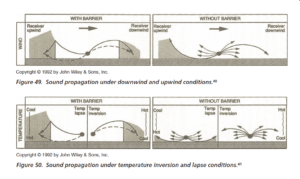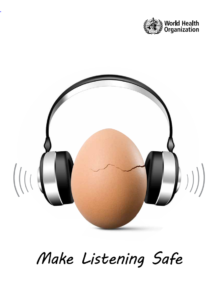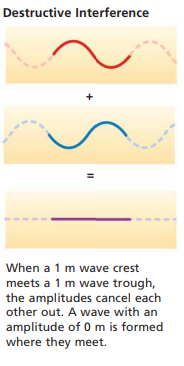International Noise Awareness Day 2018
04.25.2018 | HMMH |We’ve gathered our top experts to answer some of the questions we’ve received about noise!
International Noise Awareness Day was founded in 1996 by the Center of Hearing and Communication in an effort to raise awareness about how unwanted sound (or noise in technical terms) can affect health and wellbeing. Here’s what HMMH’s experts have to say:
Q: Why can you hear conversations long distances across a small lake in the early evening but not during the day and almost never anywhere else?
Answered by Senior Vice President Chris Menge
A: As the sun begins to set, the warm air above the lake rises, and cooler air collects over the relatively cool lake. This sets up a temperature inversion, with warmer air above and cooler air below, the reverse of the daytime situation. Sound travels faster in warmer air, so sound waves traveling across the lake from conversations along the shore will bend (“refract”) down as they travel upward instead of continuing to expand up and away from the speaker.

Environmental Noise Pollution, Patrick F. Cunniff, University of Maryland, John Wiley & Sons, Inc. 1977.
The sound will then bounce off the acoustically hard water surface, travel upward, then bend down and bounce again, effectively skipping across the lake. Because the sound is effectively trapped in the cool air layer near the lake, it isn’t reduced in the vertical direction by the normal spreading with distance, and sounds much louder at a distance than it does under normal atmospheric conditions.
Q: Why is it a lot noisier downwind from a source than upwind?
Answered by Senior Vice President Chris Menge
A: When the wind is blowing, the wind speed is faster above the ground than it is near the ground. That faster wind speed above the ground bends (“refracts”) the sound waves traveling in it. When the sound is traveling with the wind, the faster wind bends the sound waves downward. When the sound is traveling into the wind, the faster head winds aloft slow the sound waves more, and the waves bend upward with the higher speeds at the ground. Downward-bending sound waves will increase the loudness of sound emitted by a sound source by bringing sound that travels well above the ground back down to listeners near the ground. With no wind, the direct sound path may include some shielding from terrain or buildings, or it might

Ver, Istvan L., and Leo L. Beranek. “Noise and Vibration Control Engineering.” Google Books. N.p., n.d. Web. 25 Apr. 2018.
have soft ground that can absorb sound along the way. Sound waves bending upward away from the ground into the wind create a “shadow zone”, and don’t reach the listener on a direct path, so the loudness is generally less than it is with no wind at all.
Q: How does sound-absorbing material really absorb sound?
Answered by Senior Consultant Brad Dunkin
A: Rooms like classrooms and restaurants often have features like acoustic ceiling tiles and sound-absorbing wall panels. This can make the room quieter and make conversation easier to understand. Here’s how this works.
Sound is an organized, coordinated motion of air molecules. The air does not flow (like wind), but it does move back and forth around its original position. This motion causes similar oscillations in neighboring air, and this oscillation is transmitted through the air to create a sound wave.
When these oscillations come in contact with a solid surface, the motion of the air is disrupted by this contact due to friction. This results in the organized motion of the sound wave being transformed into a disorganized motion that can’t travel like a wave.

Photo courtesy of Graham Garfield http://bit.ly/2r0oqNf
Sound absorbing material takes advantage of this by creating many small surfaces for the sound to come in contact with. Materials like open-cell foam and fabrics consist of small pores that provide a large surface area to create disturbances within the oscillating air.
Not all the sound is absorbed by the material, but in an enclosed space, the sound that isn’t absorbed will bounce around the room, and each time it bounces off materials like ceiling tiles and wall panels, as well as carpets, drapes, and people’s clothes, it loses more energy. Without these materials, the hard, smooth surfaces in the room would reflect the sound with most of its energy intact, making the room louder.
Q: How long should my kid listen to his iPhone with earbuds?
Answered by President & CEO Mary Ellen Eagan
A: As a parent of teens, and a noise consultant, I’m constantly yelling “Turn it down”, not just because I’ve already heard everything Taylor Swift has to say, but because it’s BAD FOR YOU. Here are some facts, from the World Health Organization (WHO):
- Around 466 million people worldwide have disabling hearing loss, and 34 million of these are children.
- It is estimated that by 2050 over 900 million people will have disabling hearing loss.
- Hearing loss may result from genetic causes, complications at birth, certain infectious diseases, chronic ear infections, the use of particular drugs, exposure to excessive noise, and ageing.
- 60% of childhood hearing loss is due to preventable causes.
- 1.1 billion young people (aged between 12–35 years) are at risk of hearing loss due to exposure to noise in recreational settings.
- Unaddressed hearing loss poses an annual global cost of 750 billion international dollars. Interventions to prevent, identify and address hearing loss are cost-effective and can bring great benefit to individuals.
- People with hearing loss benefit from early identification; use of hearing aids, cochlear implants and other assistive devices; captioning and sign language; and other forms of educational and social support.
WHO provides a number of recommendations, including other resources, in this brochure.

Fortunately, for many of us, the solution is quite simple – just turn it to the left!
And for those of you with little kids, here’s a cute video:

Gook luck! Let me know how it goes.
Q: Can sound cancel other noise/why are there noise canceling headphones, but no noise canceling devices for highway and aviation noise?
Answered by Principal Consultant Joe Czech and Senior Consultant Brad Dunkin
A: Yes. Sound consists of pressure waves. “Anti-sound” can be created which has the same amplitude of the offending sound but with a phase 180 degrees from the offending sound. When the offending sound and the ‘anti-sound’ are played together, they cancel each other out.
‘Noise cancelling’ headphones work the same way. The headphones have a microphone, a little computer and tiny speakers in them that samples the offending sound and produces a sound of the same amplitude and opposite phase, providing the quieting effect. The tricky part is matching the frequency (spectrum) and amplitude of the offending sound.

Source: http://bit.ly/2Hs5iii
What about noise canceling devices for outdoor highway and aviation noise?
Canceling noise with headphones on your ears is one thing but cancelling noise outdoors from highways and aircraft is a much tougher problem. This is because the canceling sound has to be produced over an area that is huge compared to your ears, and also because the canceling sound has to be produced in the same direction that the original sound is traveling. Instead of a single microphone and speaker next to your ear, this requires a large array of microphones and speakers, with sophisticated signal processing to coordinate them. If the offending noise isn’t matched perfectly, one can actually be adding noise to the environment, rather than subtracting or canceling it. Some research has been done in the area of cancelling aircraft and highway noise but more is needed. HMMH can help.





